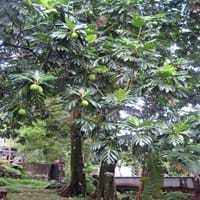Life Span
Annual and Perennial
Perennial
Type
Tender Perennial
Fruit
Origin
South Africa
Southeastern Asia, Melanesia, Micronesia
Types
Osteospermum acanthospermum, Osteospermum amplectens, Osteospermum burttianum
Jackfruit, Breadnut, Figs
Number of Varieties
Not Available
Habitat
Coastal Regions, Sandy areas, Terrestrial
Lowland evergreen rainforest, Riverine swamp forest
USDA Hardiness Zone
10-11
10-15
AHS Heat Zone
Not Available
12-9
Sunset Zone
8, 9, 12, 13, 14, 15, 16, 17, 18, 19, 20, 21, 22, 23, 24
H2
Habit
Clump-Forming
Oval or Rounded
Flower Color
White, Purple, Blue Violet
Yellow green
Flower Color Modifier
Bicolor
Bicolor
Fruit Color
Not Available
Yellow, Green, Yellow green, Brown
Leaf Color in Spring
Green
Dark Green
Leaf Color in Summer
Green
Dark Green
Leaf Color in Fall
Green, Blue Green
Dark Green
Leaf Color in Winter
Light Green
Light Green
Leaf Shape
Irregular
Irregular
Plant Season
Spring, Summer, Fall
Spring, Summer, Fall, Winter
Sunlight
Full Sun, Partial Sun
Full Sun, Partial Sun
Type of Soil
Loam
Loam, Sand
The pH of Soil
Neutral
Acidic, Neutral, Alkaline
Soil Drainage
Well drained
Average
Bloom Time
Late Spring, Early Summer, Summer, Late Summer, Early Fall, Fall
Indeterminate
Tolerances
Drought
Drought
Where to Plant?
Container
Ground
How to Plant?
Seedlings, Stem Cutting
Grafting, Rooted stem cutting, Seedlings
Plant Maintenance
Medium
Medium
Watering Requirements
Do Not over Water, Keep ground moist
Average Water Needs, Never Over-water, occasional watering once established, Water daily during growing season, Water Deeply
In Summer
Lots of watering
Lots of watering
In Spring
Moderate
Moderate
In Winter
Average Water
Average Water
Soil pH
Neutral
Acidic, Neutral, Alkaline
Soil Type
Loam
Loam, Sand
Soil Drainage Capacity
Well drained
Average
Sun Exposure
Full Sun, Partial Sun
Full Sun, Partial Sun
Pruning
Remove damaged leaves, Remove dead branches, Remove dead leaves
Prune every year, Prune if you want to improve plant shape, Remove branches, Remove damaged leaves, Remove dead branches, Remove dead leaves, Remove dead or diseased plant parts
Fertilizers
All-Purpose Liquid Fertilizer
20-20-20 amount, All-Purpose Liquid Fertilizer
Pests and Diseases
Red blotch
Red blotch
Plant Tolerance
Drought
Drought
Flower Petal Number
Single
Not Available
Foliage Texture
Medium
Coarse
Foliage Sheen
Not Available
Glossy
Attracts
Bees, Birds, Butterflies
Birds, Not Available
Allergy
Not Available
allergic reaction
Aesthetic Uses
Beautification, Showy Purposes
Not Used For Aesthetic Purpose
Beauty Benefits
Not Available
Good for skin, Promotes Healthy Hair, Removes dandruff, Speed hair growth
Environmental Uses
Air purification
Air purification, Nesting sites for birds, Shadow Tree, Wildlife
Medicinal Uses
Not Applicable
Cancer, cholesterol-lowering, Heart problems, High cholestrol, Immunity, Skin Disorders, Weight loss
Part of Plant Used
Flowers
Fruits
Other Uses
Used as Ornamental plant
Used As Food, Used for its medicinal properties
Used As Indoor Plant
No
No
Used As Outdoor Plant
Yes
Yes
Garden Design
Bedding Plant, Container, Cutflower, Foundation, Groundcover, Hanging Basket, Mixed Border, Rock Garden / Wall
Edible, Feature Plant, Fruit / Fruit Tree, Shade Trees, Tropical
Botanical Name
OSTEOSPERMUM fruticosum
ARTOCARPUS altilis
Common Name
Shrubby Daisybush, Trailing African Daisy
Breadfruit
In Hindi
Blue Eyed Daisy Plant
Breadfruit Tree
In German
Blue Eyed Daisy Pflanze
Brotfruchtbaum
In French
Blue Eyed Daisy Plante
Breadfruit Arbre
In Spanish
Planta observada azul de la margarita
árbol del pan
In Greek
Μπλε Eyed Daisy Φυτών
αρτόδεντρο Δέντρο
In Portuguese
Planta da margarida de olhos azuis
Árvore de fruta-pão
In Polish
Blue Eyed Daisy roślin
Breadfruit drzewo
In Latin
Daisy Blue Eyed Planta
Arum
Phylum
Magnoliophyta
Magnoliophyta
Class
Magnoliopsida
Magnoliopsida
Order
Asterales
Urticales
Family
Asteraceae
Moraceae
Genus
Osteospermum
Artocarpus
Clade
Angiosperms, Asterids, Eudicots
Angiosperms, Eudicots, Rosids
Tribe
Calenduleae
Artocarpeae
Subfamily
Asteroideae
Not Available
Importance of Blue Eyed Daisy Plant and Breadfruit
Want to have the most appropriate plant for your garden? You might want to know the importance of Blue Eyed Daisy Plant and Breadfruit. Basically, these two plants vary in many aspects. Compare Blue Eyed Daisy Plant and Breadfruit as they differ in many characteristics such as their life, care, benefits, facts, etc. Every gardener must at least have the slightest clue about the plants he wants to plant in his garden. Compare their benefits, which differ in many ways like facts and uses. The medicinal use of Blue Eyed Daisy Plant is Not Applicable whereas of Breadfruit is Cancer, cholesterol-lowering, Heart problems, High cholestrol, Immunity, Skin Disorders and Weight loss. Blue Eyed Daisy Plant has beauty benefits as follows: Not Available while Breadfruit has beauty benefits as follows: Not Available.
Compare Facts of Blue Eyed Daisy Plant vs Breadfruit
How to choose the best garden plant for your garden depending upon its facts? Here garden plant comparison will help you to solve this query. Compare the facts of Blue Eyed Daisy Plant vs Breadfruit and know which one to choose. As garden plants have benefits and other uses, allergy is also a major drawback of plants for some people. Allergic reactions of Blue Eyed Daisy Plant are Not Available whereas of Breadfruit have allergic reaction respectively. Having a fruit bearing plant in your garden can be a plus point of your garden. Blue Eyed Daisy Plant has no showy fruits and Breadfruit has showy fruits. Also Blue Eyed Daisy Plant is not flowering and Breadfruit is flowering. You can compare Blue Eyed Daisy Plant and Breadfruit facts and facts of other plants too.





